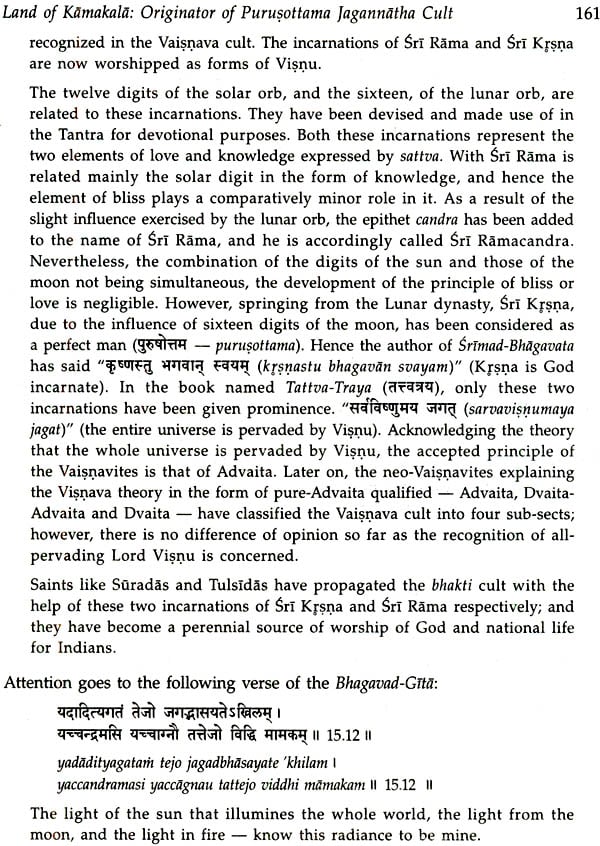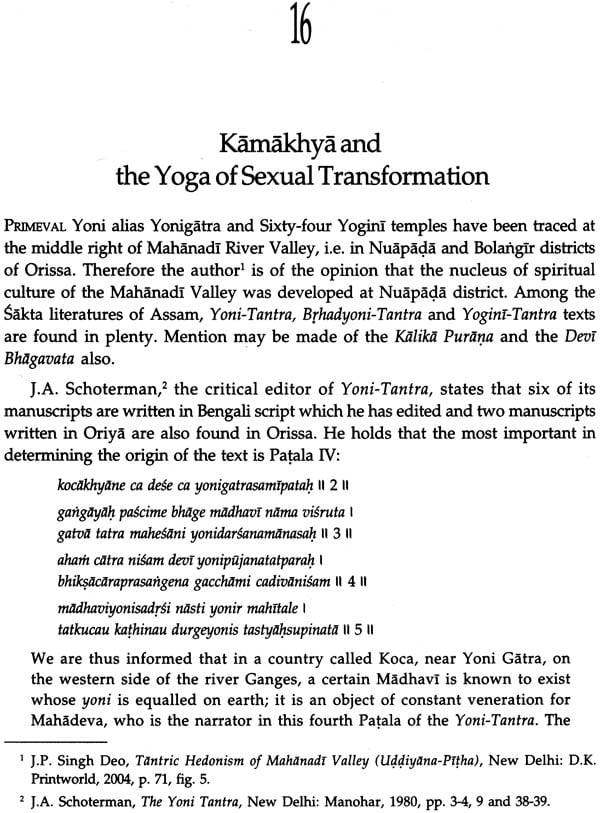The entire Mahanadi River Valley is stated to be the land of Kamakala Uddiyana Pitha and erotic art. Kamakala means the art of desire; the divine Kamakala is symbolized in the shape of two circular components, the overall shape signifying the union of male and female principles. The Uddiyana-Pitha refers to sites where Lord Siva resides in the Yogini cult that developed in this region.
The volume reveals the contributions of the Mahanadi River Valley to the origin of esoteric yogic Sadhanas (spiritual practice). Based on a deep study of archeological remains which include numerous antiquities like sculptures, the book examines the origin and development of the Yogini cult in the Mahanadi River Valley, laying stress on the Yoginis representation of the cosmic creative forces. It delves into the evolution of the Bhairava cult, the Ganapatya Tantra in Orissa, role of Mattamayura Saivism there, and the origin of the Purusottama Jagannatha cult. Exploring the aspects of sensuousness in art and its link to the tantric cults, it scrutinizes the development of erotic art in Orissa, examining erotic sculptures, erotic art in wood and palm-leaf manuscripts. Abundant in references to ancient text and modern scholarly woks on the subject and with numerous illustrations, this intensive work also explains numerous terms and differences between words and concepts in an attempt to present a thorough study of the subject.
It is a good reference for those who are interested in the history of Orissa and various cults of worship and students and teachers of arts and history, and researches on Orissan culture, which is wide and varied.
Raja Jitamitra Prasad Singh Deo is an amateur archaeologist and president of Khariar Sahitya Samiti. He is credited with the discovery of pre-history rock art of yogimath Donger, Ghat Ghumar rock art, copper plates, gold coins of Sarabhapuriya dynasty, stone seal of Panduvamsi dynasty, Kalacuri coins, terracotta, beads, sculptures of various types and many antiquities. His collections of archaeological remains have been displayed in Kahriar Branch museum in Orissa, specially established for this purpose by the Government of Orissa and at his private palace museum, at Khariar. He is also contributor to many research journals, bulletins, periodicals, magazines, souvenirs and newspapers, and finds place in international biography vol. XXXIII, Cambridge university and receiver if world’s best literature certificate, from the university of Oxford, on Hindi studies.
The Vedic rsis and tantric sages of India turned every aspect of human culture including art, architecture, sculpture, drama, music medicine, astronomy and language into a tool of spiritual awakening and realization. India, i.e. Bharatavarsa, is the land of Vedic culture which is the heritage of mankind. He Mahanadi River Valley region had given its spiritual yogic contributions and developed its own spiritual qualities, bestowed by nature and developed as the land of Kamakala, Uddiyana-Pitha (site) and erotic art, where the expression of Kama (desire) was exploited suing the early and medieval periods of Indian history to its full brim. The background prompted me to write this book, Kama in the land of Kamakala.
Scholars of international repute say, “Ancient India, we feel has much to teach us” (ISOTCOC, p. xx). Therefore, it is an appropriate time for detailed regional studies. Persuasion, intuition and archaeological findings are the key elements in this book. Tantra is a vast subject. It includes all aspects of human life including spirituality, yoga, sex and metaphysics. This book is written with an archaeological and historical perspective of the findings in the Mahanadi River valley of central eastern India. Comprising the states of Chhattisgarh and Orissa.
The author had been doing field surveys, findings, reporting, writing research papers and focusing since 1968. The archaeological findings of the author are preserved at the Khariar Branch Meseum, which was specially opened for this pupose by the Government of Orissa in 1976 and also at his personal Palace Museum, at Khariar. After the formation of the new district of Nuapada in Orissa on1 April 1993, the Khariar Branch Museum has now been shifted to the district headquarter at Nuapada.
The comparative observations and study with intuitive insights show that the experiences of yogic teachings find expressions in antiquities, temples and sculptural arts. It also shows us the experiences of the yogic masters of the bygone days.
Vedas are the sources of all religious thoughts, conducts and art of human living. The central theme of the Veda is: “Here, therer is none greater, none smaller. All have gathered together here for advancing common welfare of all” Advaita P. Ganguly states that Vedanta Philosophy, on the other hand, being are conditioned. The comic order or law is the only concept of dharma, which does not mean faith or tenet of a religion only. Dharma means duty, a good act, meritorious deed, fortune, luck, virtue, piety, welfare, justice, righteousness, natural, condition, disposition, characteristic quality, conduct, practice approved by the scriptures, law, usage, custom, just consideration, good company, chastity of a woman, etc. Rta relates all aspects of socio-cultural, religious and art of human living. To this doctrine of reality, the Mahanadi River Valley area of India had its own development of Yoga, which dealt with Kama (desire), during antediluvian culture. It was not much developed technologically, but, spiritually, it was not advanced and pure.
One of the major rivers of the peninsular India is the Mahanadi which starts from the hilly areas of Sihawa, in the south-east of lod Raipur district, now in the Kanker district of the Chhattisgarh state. It flows through the Orissa state to meet the Bay of Bengal at Paradeep. It forms the main water source and, in rainy season, the stream varies in breadth from 2 to 3 km. its bed is rich in precious stones. This river is also known as “Citrotpala” which is a name given to a portion of the Mahanadi River between two holy places Sri Rajivlocan –Ksetra and Subarnapura in Orissa. This river is mentioned as Citropala in the Mahabharata, Markandeya Purana, Brahmanda Purana, Kurma Purana, Vamana Purana and Padma Purana. Ther is a description of the Mahanadi in Skanda Purana also. A reference to it is found in Ptolemy’s work.
The origin of Sakti worship is shrouded in mystery. J.N. Baneraja considers that the ring stones, the female figurines along with the circular discs and the nude figurines of the historical period collectively establish the long continued existence of the worship of the female principle in aniconic and iconic forms. Ring stones are found in plenty at Nuapada district and the whole Mahanadi Valley in general. Broken stone piece of a circular disc is found from the Bikrampur site in Nuapada district and preserved in the private museum of the author at Khariar.
To know about the earliest primal Sakti conception, attention should be drawn to the period of geological formation. It is a truism that the course of human history in a region is in a considerable measure shaped by its physical and geographical features, which, in turn, in the ultimate, are determined by the geological history the region has passed through in the dim vista of time.
When the geological early curst was under formation, in many places the mother earth had formed the shape of female vulva, the external organ. In the words of A. Wall the external feminine sexual parts, the vulva, is called yoni in India; it is still very widely worshipped in Asiatic religions and the worshippers of feminine attributes are called yonicitas. In further reference to the vulva, we will speak of it as the yoni.
One such naturally formed female vulva or yoni of mother earth is found under a bamboo thicket at Patalaganga, a site near Boden of Nuapada district, Orissa, and worshpped as dvarsani. It should be reagerded as the earliest Sakti-Pitha of the entire Mahanadi River Valley. There are other such earthen-formed female vulva or yoni sites at other places in India and across the entire earth.
Tantra gives prominence to the female energy of Sakti. Sakti of the Sakta cult is the mother or the supreme being. Siva of the Siva cult is the father or the Supreme Being. The Tantras attempt to blend these two concepts, the motherhood and the fatherhood of God. Tantra gives importance to the eternal mother, for God’s love for the creation is like a mother’s love, deep and pure. So the earliest tantric site of the Mahanadi Valley is the Yoni Gatra worshipped as Dvarsani Deity, in the Nuapada district. The earliest Pasupati antiquity of India is found in Kalahandi district of Orissa, situated on the central right Mahanadi River Valley.
While dealing about religion of the Indus Valley Civilization, A.D. Pusalker states that among the male gods the most remarkable is a three-faced deity wearing a horned headgear, seated cross-legged on a throne, with penis erectus and surrounded by elephant, tiger, buffalo and rhinoceros, with deer appearing under the seat. It weas a number of bangles and has a pectoral round neck, and an inscription of seven letters appears at the top. This representation has at least three concepts which are usually associated with Siva that he is: (i) Trumukha, (ii) Pasupati and (iii) Yogisvara or Mahayogi. The first two aspects are apparent from the seal itself. The deity is sitting cross-legged in padmasana with eyes turned towards the tip of the nose which evidences the Yogisvara aspect of the deity. It has been suggested by some scholars that this Siva cult was borrowed by the Indo-Aryans from the Indus culture but as there is a reference to Siva in the Rgveda itself, siva may not be a later intruder in the Hindu Pantheon.
| Preface | vii | |
| Abbreviations | xi | |
| Key to Transliteration | xii | |
| List of Plates, Figures and Charts | xiii | |
| Introduction | 1 | |
| 1 | The land of Kamakala and Uddiyana-Pitha | 11 |
| 2 | The land of kamakala and Yogini cult | 24 |
| 3 | Yoginis of the Purusttama Jagannatha Temple | 34 |
| 4 | Yoginis and the Cosmic Creative Forces | 39 |
| 5 | Rare Sculptural Arts | 44 |
| 6 | Bhairava Cult and Ganapatya Tantra in Orissa | 62 |
| 7 | Mattamayura Saivism in Mahanadi Valley | 95 |
| 8 | Kosali Style of Temple Architecture | 108 |
| 9 | Mysticism of the Tantric Temples of Bauth | 124 |
| 10 | Impact of Natha Cult on the Mahanadi Valley | 132 |
| 11 | Land of Kamakala: Originator of Purusttama Jagannatha Cult | 141 |
| 12 | Jayadeva and the Gita-Govinda | 172 |
| 13 | Erection of Sun Temple in a Folk Tale | 175 |
| 14 | Erotic Art and the land of Kamakala | 186 |
| 15 | Erotic art in Sculptures, wood and palm-leaf manuscripts | 196 |
| 16 | Kamakhya and the Yoga of Sexual Transformation | 218 |
| 17 | Sensuousness in art | 236 |
| Plates | 255 | |
| Glossary | 281 | |
| Bibliography | 284 | |
| Index | 294 |
















Your cart is currently empty.